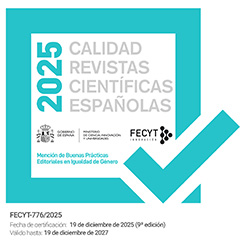Submissions
Submission Preparation Checklist
All submissions must meet the following requirements.
- The lenght of the submission adjusts to the minimum and maximum word count (5000 to 8000 words for articles and 2000 to 3000 for book reviews).
- The submission has not been previously published, nor is it before another journal for consideration (or an explanation has been provided in Comments to the Editor).
- As long as you have not received a response from one submission in this journal, a second one will not be accepted.
- The text adheres to the stylistic and bibliographic requirements outlined in the Author Guidelines, particularly following the MLA Style Manual and Guide to Scholarly Publishing (8th edition).
- If submitting to a peer-reviewed section of the journal, the instructions in Ensuring a Blind Review have been followed. It is essential to remove all personal information (full name, email or institution) from the submitted document, including metadata.
- In case of multiple authors, the criteria chosen for the order of author names and the contribution done by each of the authors are specified in a separate document.
- The language used is non-sexist and gender equal.
- The submission file is in Microsoft Word file format.
- If the contribution contains multimedia elements like illustrations, figures or tables, these should be submitted within the text at the pertinent points and as separate files in an appropiate format (PNG extension with a maximum weight of 125MB), all together in a compressed archive.
- Where available, URLs for the references have been provided.
- In case of receiving external funding, authors must communicate all relevant information in the metadata and in a footnote right after the title, namely, the funding agency, call, project reference number and (optionally) title.
- If the research requires humans’ participation, authors should sign a form stating that informed consent was obtained for experimentation with them stating that all procedures were performed in compliance with relevant laws and institutional guidelines.
- An extra document with details about the author is to be submitted too. This should contain title of the text, full name, institution, academic/professional post, telephone numbers, post address, email, ORCID number and a brief resumé of 50 words maximum.
Copyright Notice
Authors who publish with this journal agree to retain copyright and grant the journal right of first publication with the work simultaneously licensed under a Creative Commons Attribution License that allows others to share the work with an acknowledgement of the work's authorship and initial publication in this journal. Also, authors will retain the rights on their work, even if they will be granting The Grove. Working Papers on English Studies a non-exclusive right of use to reproduce, edit, distribute, publicly communicate and show their work. Therefore, authors are free to engage in additional, independent contracts for non-exclusive distribution of the works published in this journal (such as uploading them to an institutional repository or publishing them in a book), as long as the fact that the manuscripts were first published in this journal is acknowledged. Authors authorise The Grove to publish them in the journal and to include them in the indexing and abstracting services, academic databases and repositories the journal participates in. Users who adapt (i.e., remix, transform or build upon the material) must distribute their contributions under the same licence as the original.
Self-archiving is also permitted, once the article has been published, so that authors are allowed to deposit the published PDF version of their articles in academic and/or institutional repositories, without fee or embargo. Authors may also post their individual articles on their personal websites, again on condition that the original link to the online edition is provided.
Privacy Statement
All names and email addresses entered in this magazine will be used exclusively for the stated purposes and will not be provided to third parties or used for other purposes.
























